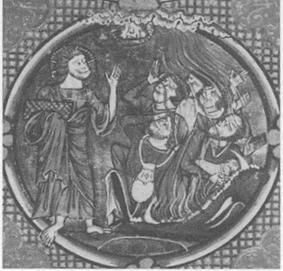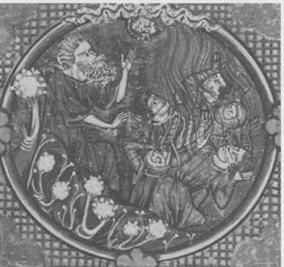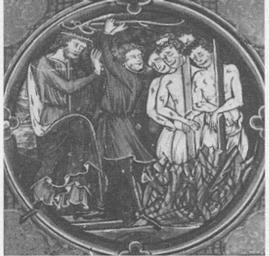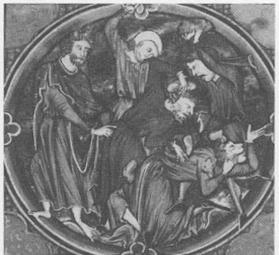Martyrdom
in Jewish Traditions
Shira Lander
Catholic-Jewish
Consultation Committee Meeting
St. Mary’s Seminary, Baltimore, MD
Bishops Committee
on Ecumenical and Interreligious Affairs
and
December 11, 2003
the National Council of Synagogues
Perhaps the most important feature of martyrology in Jewish
traditions we might observe is the marginal role it plays in contemporary
Western Jewish practice and belief. Martyrdom is featured only twice in the
current liturgical corpora. The most extensive martyrology is the liturgical
poem eleh ezkarah, found in the Day of Atonement’s long afternoon, or
musaf, service. In that afternoon service—the reader’s repetition of the
Amidah—this poem is sandwiched between the Avodah Service, which recounts the
High Priest’s holiest rituals performed in the ancient Temple on the Day of Atonement, and the oft-repeated communal confession of sins. I
will examine this poem more extensively later. The second place where martyrdom
is highlighted is in the kinot, or lamentations, of the Ninth of Av, on which
the Temple destructions are commemorated. These lamentations include a few of the many
poetic martyrologies which were composed by European Jews during the Middle
Ages.
The subject of martyrdom appears scattered throughout the
daily and Sabbath liturgy in such prayers as “Av
Harachamim,” calling on god’s mercy for the sake of those “who laid
down their lives for the sanctification of the divine name.” The phenomenon is
also alluded to in several other prayers: the Avinu
Malkeinu, our Father Our King, where God’s mercy and forgiveness is
invoked “for the sake of those who were killed for your holy name;” the
Yizkor recitation of memorial prayers for the martyrs; All of these liturgical
commemorations of martyrdom owe their roots to a period following the
persecutions of the 11th and 12th c. Crusades, a formative period for the
development of Jewish martyrology.
Other prayers have hagiographic associations with
martyrdom, although their content does not explicitly address the topic: one
famous example is the liturgical poem recited on Rosh HaShanah, the unetaneh
tokef prayer, attributed to Rabbi Amnon of Mayence (Metz).
Legend relates that after being brutally tortured for rejecting apostasy, he
asked to be conveyed to the synagogue, “where the congregation was assembled
for the holy day services. He asked for the privilege of reciting personal
prayer…As he finished his hymn, he expired.”
It is clear that the role of martyrdom in Jewish traditions
correlates directly to communities’ contemporary experiences. In times when
persecution is either imminently feared or experienced, martyrologies flourish.
These generally appear first in narrative form and then subsequently interpreted
theologically through poems. Many of these poems were then used in the course of
prayer, and it is in this usage that most of us encounter the martyrological
traditions. Prior to the Middle Ages, however, martyrological traditions are
more difficult to locate. It is with this ancient material that I will thus
begin, and then attempt to trace their development chronologically through the
post-Crusade European Jewish traditions to the early modern period. I will
conclude with reflections on the post-Shoah age.
Martyrdom in Second Temple
Judaism
Most scholars consider the Hasmonean traditions preserved
in 2 and 4 Maccabees as representing the earliest Jewish strata of martyrology.
This depends on a definition of martyrdom that includes:
-
public declaration of one’s allegiance to God and
Torah in the face of official demands to betray that allegiance or die;
-
the perception that this act fulfills a religious
mandate (that death is what God demands when the alternative is apostasy);
-
the passionate commitment of the adherent to both God
and Torah;
-
these deaths serve a larger redemptive purpose,
generally for Israel as a whole; AND
-
death (or near death experience of Isaac—as
interpreted later—or Daniel).
The first instances of martyrdom are anonymous and brief,
therefore less familiar to those of us for whom the books of the Maccabees are
historical relics and not part of our lectionary.
These are two examples of citizens flaunting the restrictive religious measures
imposed by King Antiochus Epiphanes. First there are the two mothers and their
circumcised infants who are hurled from the city walls in public view. Second is
a group of secret Sabbath-observers are burned to death. Commenting on these
deaths, the author notes, “their piety kept them from defending themselves, in
view of their regard for that most holy day (2 Macc 6. 11).” Sabbath
observance, in the mind of those martyred and the author, overrides the dictates
of self-defense, a position which would be later overturned by the Palestinian
Rabbis. As consolation to the reader, the author appeals:
Now I urge those who read this book not to be depressed by
such calamities, but to recognize that these punishments were designed not to
destroy but to discipline our people. It is a sign of great kindness not to
ignore the impious for a long time, but to punish them immediately. For in the
case of the other nations the Lord waits patiently to punish them until they
have reached the full measure of their sins; but he does not deal in this way
with us, in order that he may not take vengeance on us afterward when our sins
have reached their height. Therefore he never withdraws his mercy from us (2
Macc 6.12-16).
Here we see the seeds of a concept later expressed in
Rabbinic literature as “yisurin shel ahava” or the sufferings of love that
befall the righteous (Avot 6.5).
More familiar are the martyrdoms of the elder scribe
Eleazer and those of the pious mother and her seven sons. Both episodes take
place in Jerusalem. The protagonists are faced with the demands to engage in the sacrificial cult
of Zeus Olympios at the behest of the ruling officials. Most interesting is the
recognition on the part of the oppressor of the power of the violation being
demanded to mislead a much broader segment of the community, namely those who
are watching the proceedings. The officials ask Eleazer to eat pork or to pretend
to eat pork by eating his own kosher meat in the context of the cultic ritual (2
Macc 6.21). This isolates a crucial component of the definition of martyrdom:
that it be public. In defiance of the offer, Eleazar declares, “I will show
myself worthy of my old age and set a noble example for the young of how to die
a good death willingly and nobly for the revered and holy laws (2 Macc
6.27-8).” The power of betrayal is outdone by the power of devotion.
A second, more famous, episode is the martyrdom of the
mother and her seven sons. Here Antiochus himself figures as the oppressor, and
he brutally tortures each son before the eyes of their mother and a large crowd.
It is the testimony of the second son which first connects the death of martyrs
to the promise of their resurrection, a claim repeated in the third and fourth
son: “the King of the universe will raise us up to an everlasting renewal of
life, because we have died for his laws” (2 Macc 7.9). Thus, the martyrs’
deaths are understood as not only vicariously redemptive for the entire people
Israel, but they offer personal redemption as well. This is later characterized by
Rabbinic literature as the s’charan shel
tzaddikim, the rewards of the righteous (Bereishit Rabbah 62.2) and for
martyrs, as we shall see, entails their immediate ascent to the highest heavenly
tier.
To return to the Maccabees, the sixth son presents a view
of the mortal suffering that will leave an indelible mark in Jewish theology and
liturgy as “mipnei hataeinu”—because of our own sins, as he says, “…[W]e
are suffering these things on our own account, because of our sins against our
own God (2 Macc 7.18).” Certainly this theology dates as far back as the first
Babylonian exile, but those examples were expressions of corporate suffering.
The Maccabean accounts portray the trials of individuals, who are themselves
blameless, suffering on behalf of the community’s sins.
The mother is revered as a model of courage and faith, as
she implores her children to resist the imperial demands for apostasy. The
seventh son heeds her advice, proclaiming at his death, “I obey the command of
the law that was given to our fathers through Moses (2 Macc 7.30).” The
triumph of these exemplars is treated even more philosophically in the later
work, 4 Maccabees, where the martyrdoms are cast as masteries of self-controlled
reason over bodily tortures. This version is generally viewed by scholars as a
radical adaptation of Jewish martyrdom to the Stoic ideal of mind-over-matter as
exemplified by the noble death tradition. Despite this interpretive framework,
the narrative core remains essentially intact.
Post-70 Roman Period Traditions
These early Hasmonean traditions are found only in the
Greek Jewish Scriptures of the Graeco-Roman Period; they are not preserved as
such, in their historical context, by later Rabbinic circles. Yet there is
evidence in both Josephus and in the writings of fourth century church fathers
that the Jews of Modin and Antioch revered the Maccabean martyrs at their tombs. Josephus describes a
“memorial” for Judah Maccabee in Modin, who is seen as one who gave his life
“for the liberty of his nation” in the Hellenistic noble warrior tradition.
Jews at Antioch built a shrine which purportedly contained the bones of the Maccabean mother of
the seven sons.
Jews as well as Christians would visit this shrine seeking healing and other
miracles, an intermingling evidenced at the shrines of other Biblical sites in
the Greek east.
Presumably the attraction of Jews and Christians to the
Maccabean shrine had gone unnoticed up until the fourth century. Prior to this
cataclysmic century, such sites were revered by Jews and Christians alike. Yet,
as Jewish and Christian identity became increasingly defined
oppositionally, that is over-and-against the other, holy places became
sites of contestation. Particularly in the wake of the Emperor Julian’s
attempts to rebuild the Jerusalem
Temple, initiated by an agreement with the Jews of Antioch, and the persistence of
Arian Christianity among the Roman Emperors, like Valens, Orthodox Christians
found themselves at a political disadvantage. The Maccabean martyrs were clearly
not on their side, despite the power manifest by their miracles. Orthodox
Christians, therefore, built a competing Church of the Maccabees, the Kerateion
(=Jewish Quarter), to try to reclaim the Maccabees as their own.
In fact the bishop of Hippo, Augustine—as far distant as North Africa —preaches a sermon on the newly instituted Maccabean Feast Day (Aug. 1—for a
awhile it fluctuated with a December date, presumably inspired by Hanukah):
[T]he Maccabees really are martyrs of Christ. That's why
it is not unsuitable, not in the least improper, but on the contrary
absolutely right for their day and their solemnity to be celebrated especially
by Christians. What do the Jews know about such a celebration? Word is going
round that there is a basilica of the Holy Maccabees in Antioch; in the very city, that is to say, which is called by the name of that
persecuting king. They endured the persecution of the wicked King Antiochus,
and the memory of their martyrdom is celebrated in Antioch, so that both the name of the one who persecuted and the memory of the one
who crowned them are heard together. This basilica is owned Christians, was
built by Christians. It is we who keep (teneo),
we who celebrate their memory; it is among us that thousands of holy martyrs
throughout the world have imitated their sufferings.
This evidence supports at least part of the recent thesis
of Daniel Boyarin, that martyrologies were vehicles through which Jews and
Christians competed for adherents and negotiated their conflicting claims to
ultimate truth.
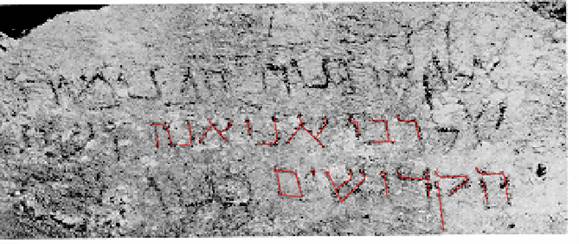 Roughly
contemporary with this shrine is the only piece of epigraphic evidence I could
find for Jewish martyrdom during this period. A Hebrew inscription (#239) from
the Beit She’arim catacombs in the Galilee
identifies a sarcophagus as containing the remains of Rabi Aniana and his
brother, whose name is unreadable:
Roughly
contemporary with this shrine is the only piece of epigraphic evidence I could
find for Jewish martyrdom during this period. A Hebrew inscription (#239) from
the Beit She’arim catacombs in the Galilee
identifies a sarcophagus as containing the remains of Rabi Aniana and his
brother, whose name is unreadable:
The inscription refers to the two brothers as “hakedoshim,”
using the adjective for holy in a substantive—exactly the terminology we see
in Rabbinic texts referring to martyrs (Sifre Deut, Haazinu 333; Berakhah 344,
citing Deut. 33.3—“all the kedoshim are in Your hand”).
Can this Aniana be identified with either the Rabi Hananya ben Teradyon
(martyred in 2nd c. Siknin in Galilee) or the Rabi Chanina ben Chachinai (pupil of Akiba, martyred with him?) of Eleh
Ezkerah? The thought is intriguing, but ultimately impossible to determine.
As martyrs took a more prominent role in the beliefs and
practices of Christians, and Christians gained Imperial power, Rabbinic leaders
ceded claims to the Maccabean martyrs and were forced to relinquish control of
the Maccabean shrine in Antioch. The scarce occurrence of these second century BCE heroes in Rabbinic
literature is often cast by scholars as solely motivated by political and
theological concerns: the Rabbis did not approve of the Maccabees on two counts.
First, because they believed in military opposition, a stance which had produced
the devastating result of curtailing Judean sovereignty; and second, because the
Maccabees-qua-Hasmoneans eventually capitulated to the very Hellenism they set
out to oppose. Yet a third reason may account for both the scant Rabbinic
evidence and for the exclusion of the books of the Maccabees from the Hebrew
Bible. As Christians laid increasing claim to martyrs, martyrdom, and
martyrologies, not to mention the frequency with which early Christian exegetes
portrayed the Maccabean martyrs in particular as Jewish prefigurations of Jesus,
Jews were less motivated to preserve these accounts as their own. When
Christians were writing, Exhortations to
Martyrdom (Origen, e.g.), Rabbinic Jews were proscribing martyrdom except in
the three desperate cases of being forced to engage in idolatry [avodah zarah], incest [gilui
arayot], or to commit murder [shfichut
damim] (P. T. Sheviith 4.2, 35a;
Tosefta Shabbat 16.14—pikuah nefesh
does not apply in these 3 cases [the law is not tanaitic], later
Sanhedrin 74a). The discussion considers the violation of even minor halakhic
infractions, which some opinions consider in force only when such violation is
demanded publicly. One account even has two disciples trading in their fringed
garments for Roman togas in order to avoid persecution (Gen. Rabbah, Vayyishlach
82.8). This halakhic framework reveals an increasing attempt to relegate
martyrdom and martyrology to the margins of Rabbinic Judaism.
Martyrdom in Rabbinic Literature
As a result of this moderating tendancy in Rabbinic
literature, the tale of the Maccabean mother and her seven sons is torn from its
Hasmonean context and re-placed in the context of Judea’s rebellion against
Rome.
In the Babylonian Talmud, Vilna edition, the mother is given the name Miriam.
This form of the story, unlike the Maccabees versions, follows the genre of
Roman trial transcripts replete with a final moral exhortation to the emperor on
the virtues of non-idolatry, a form used frequently by early Christian
martyrologists. The sons refuse to bow down to the idol (avodat kochabim)
on the basis of a series of prooftexts against idolatry and enjoining exclusive
devotion to God. The mother implores her last son to have courage, so that he
may join his other brothers and occupy the “bosom of our father Abraham” (Buber
ed.). Aside from this last comment, the text lacks all of the theological
suggestions about martyrdom found in the versions recounted in 2 and 4 Maccabees.
The formulaic procession of prooftexts forbidding idolatry and mandating
exclusive devotion suggests that the broad range of meanings associated with
martyrdom are being filtered out: one theological note is being played.
The earliest explicit Rabbinic account of martyrdom
reflects some of the range of meanings and concern with historical context found
in the books of the Maccabees. The death of Pappus and Julian (“Lulianus”),
recounted in Sifra Emor (9.5), takes place under the reign of Trajan (98-117) in Syrian
Laodicaea (cited in later texts as “Lod”).
It is quite possible that these two Jews were swept up in the wave of
persecution recorded by Pliny in his correspondence with Trajan during his years
as governor from 111-113, where even he indicates confusion over the identity of
those who have been dragged before the tribunal on charges of impiety (aimed at
Christians). It is equally possible that Laodicea, like other cities in Asia Minor, punished Jews who had participated in the Diaspora rebellions of 115-117.
The narrative occurs as an exegesis of Leviticus 22.32,
“You shall not profane my Holy name so that I may be sanctified among the
children of Israel.” The phrase “that I may be sanctified [v’nikdashti]” is taken to
indicate “kiddush hashem [sanctification of the divine name]” (9.4).
The text then pronounces the dictum that God does not answer the requests of
martyrs who die in order to produce a miracle, citing the examples in the book
of Daniel of Hananiah, Mishael, and Azariah (Dan. 3.16-18). The story of the
trial and execution of the two brothers, Pappus and Julian, follows. The Emperor
Trajan asks whether they belong to the same people as the three young men from
Daniel, to which they reply affirmatively. Trajan suggests that if their God
delivered them from the furnace, then Pappus and Julian should expect to be
delivered from execution. They reply with a stock response found in other
Rabbinic martyrdom accounts: while the young men were purely innocent and
Nebuchanezzar was worthy of a miracle, the two Laodiceans are guilty and Trajan
is a wicked king. They are then beaten to death.
A similar treatment of the theodicy question posed by
martyrdom appears in the narratives of the second century rabbis Shimon ben
Gamliel and Yishmael. The account strays from the realm of history into
mythology, a tendency perhaps represented by the earliest Maccabean accounts.
The martyrdoms are likely to have been inspired by a prophecy attributed to the
earlier sage, Shmuel ha-katan, that “Shimon and Yishmael are destined for the
sword, the fellows for slaughter, and the rest of the people for pillage” (Tos.
Sotah 13.4).
The story is found in the third century collection, Mekhilta deRabbi Yishmael (Mishpatim 18), as well as in Semahot (8.8), and Avot de Rabbi Natan
(both versions, 38A & 41B). In its earliest version, the story is placed in
a tractate that explicates Exodus 22.20-23, yet is almost exclusively devoted to
the eschatological theme of final judgment. The first item under discussion is
the reward of gentiles
who abandon idolatry along with that of the Jews. Abraham’s circumcision is
postponed by God, according to this interpretation, to permit the inclusion of
gentiles among those justified, whether they be garei tzedek (circumcised proselytes) or y’rei shamayim (uncircumcised God-fearers). In this covenantal
eschatology, both Jews and Gentiles are redeemed by modeling themselves after
Abraham. The discussion then shifts to the punishment of the righteous in this
world. It is in this context that the martyrdom narrative is presented.
The midrash explicates Exodus 22.21-3: “If you oppress
the [widow or orphan], and if they cry out to Me, I will…kill you with the
sword…” The account begins abruptly to shore up the interpretation. As they
are led to execution, the rabbis question why they are about to be beheaded.
They wish to know the sin for which they are being punished. They interpret the
word “oppress” in the Scriptural verse to mean “delay,” whereby they
determine that in the course of their rabbinic duties, they had kept someone
waiting. Thus, they go to their deaths reassured, able to accept the verdict.
Since they are being beheaded, one would conclude (if the
account were historical) that they were Roman citizens, that is to say members
of the Roman aristocracy. If this is the case, then the Roman crime for which
they are being punished would likely be maiestas,
which in the second century context probably entailed failure to demonstrate
one’s loyalty to Rome either through rebellion or by refusing to participate in the Imperial cult.
Yet all indications of such historical context are gone. The text is only
concerned with exegesis in the theological context of theodicy and eschatology.
An epilogue to the martyrdoms of Shimon and Yishmael
portrays Rabbi Akiba interpreting the meaning of the events as harbingers of a
“great persecution” (פורענות
citing the succession of three verses Is. 57.1, 57.2, and 57.3). Akiba warns his
disciples to prepare for the worst. The discussion continues to affirm that mass
suffering will incite God’s mercy for the righteous and God’s wrath for the
wicked. Ultimately, as the tractate concludes, God will remain steadfast to the
covenant, send “a redeemer to Zion” (Is. 59.20), and they will receive eternal life in the world to come.
In their midrashic context, the martyrdoms are interpreted as heralding the
eschaton.
Chronologically close to these martyrdoms is that of R.
Hanina (some mss read Hananyia!) ben Teradion, dated to the wake of Judea’s second rebellion. This account appears in Judean and Babylonian versions.
As presented in its earliest form (Sifre
Deuteronomy 307—dated 3rd
c.), the theological thrust is tsidduk
ha-din, the ‘justification of verdict,’ in which God’s decision to
take the life of a most devout scholar is affirmed as just.
A series of prooftexts establishes God’s perfection, in the context of which
Hanina’s martyrdom is cast as a just decision. The seeming injustice of his
and his wife’s death is rebalanced by their reward of eternal life. [Rabbi Judah
haNasi’s comment identifies them as “righteous ones.” (tzadikim)] A philosopher bystander points this out to the government
officials, who condemn him to the same end, which he welcomes as “good
news.” The joy of the afterlife as welcome recompense for martyrdom is a theme
we saw in the Maccabean accounts.
In its Babylonian Talmudic form (Avodah
Zarah 17b-18a), however, the story changes dramatically. Here we have a
cycle of stories about Hanina that virtually constitute acta
martyris. Like the martyr acts, this appears to be a collection of accounts
from disparate, independent sources.
The original theological focus on tsidduk
ha-din is preserved, yet a number of additions recast the martyrdom.
-
Hanina is arrested together with his colleage R.
El’azar ben Perata (mss Munich —heretic). In a prison conversation, Hanina reveals that his crime will be
more harshly punished, since he only engaged in Torah study but neglected
deeds of lovingkindness.
-
Hanina’s justification of God’s decree is supported
by a later rabbinic opinion.
-
El’azar ben Perata is miraculously saved from
execution by the intervention of Elijah.
-
The account of Hanina’s trial is interrupted by an
anonymous narrator who explains that his charge (from the perspective of the
heavenly court) was blasphemy: reciting the divine name in public. His wife
was also sentenced to death for not preventing him from doing so.
-
This discussion is followed by a story about Hanina’s
visit to a colleague who was ill. The stricken rabbi Yose warns Hanina of
the danger of persisting to disregard the supposed Roman decree against
Torah study and teaching. Hanina asks his friend if he is destined for
eternal life, to which he replies obliquely, “let your fate be my fate.”
-
Hanina is condemned to die. He is wrapped in his Torah
scroll and burned to death, during which he has a miraculous vision of the
letters of the scroll escaping the fire and ascending into heaven.
-
Finally, Hanina’s inquisitor offers to speed the
death by increasing the flame, if Hanina will also grant him the reward of
eternal life. A heavenly voice declares that both have been summoned to
eternal life. Rabbi Judah haNasi comments, this time in tears, that Hanina acquired eternal life
instantaneously (as opposed to others for whom it takes many years).
Hanina’s martyrdom is thus tempered in the Babylonian
version. This is by no means a celebration of dying for God. Two approving
alternatives to voluntary death are offered by R. El’azar and R. Yose.
Although the reward for martyrdom is still portrayed as eternal life, it is
almost begrudgingly awarded, despite Hanina’s heinous sin of blasphemy. The
original context of tzidduk ha-din is
attenuated by the seriousness of Hanina’s guilt. A brand new element is the
miraculous power of the Rabbi to bring the inquisitor along with him into
heaven. The power of the martyr-rabbi is so great that he can effect what was
formerly only thought to lie within God’s grasp. This new cosmology is part of
a larger literary framework the rabbis create where they portray themselves the
regulators of the many forces and spirits that manage daily life.
Finally, what are we to make of the addition of Judah haNasi’s tears? They are tears of sadness shed for the calamity of martyrdom.
Despite the power of the martyr to overcome death through attainment of eternal
life, it is, nevertheless, an unwelcome fate. In the Babylonian version, the
sentence of martyrdom is not “good news.” In this account, there is no joy
in martyrdom.
During this same second century persecution, Bar Kosiba’s
great Rabbinic supporter, Rabbi Akiba, is tried and executed. This account first
appears in the Jerusalem Talmud (P. Berakhot
9.7, P. Sotah 5.7). Although this version is the earliest account, it is
probably best dated to the end of the Jerusalem Talmud’s redaction, perhaps
the fourth century, since it is in Aramaic. The narrative appears after a
discussion about the requirement to recite a blessing for bad as well as good
situations. For example, upon hearing of a father’s death, one recites baruch
dayan haemet, still used today (P. Berakhot
9. 2).
The discussion wends its way to the conclusion that even if God takes your own
life, you are obliged to recite a blessing. The text cited as prooftext, “with
all your heart, with all your being, and with all your resources” from the
first paragraph of the Shema (Deut. 6.5), leads into the chronicle of Akiba’s
martyrdom, since legend records that he was tried at the requisite time for
reciting this creedal affirmation. As Akiba is being tortured, he laughs, since
he now finally understands the ultimate meaning of the reference to being,
nafshecha, since he had already dedicated his entire life to loving God with his
entire cognitive and emotional faculties, or heart, and with all of his
resources. He now understands that nafshecha
refers to his being; martyrdom offers Akiba the opportunity to demonstrate the
fulfillment of his love by laying down his life for God, or more specifically
for his obedience to God’s Torah. To illustrate Akiba’s epiphany, the text
recounts that it was at the very moment that he recited the words
“nafshecha” that his nefesh departed.
The narrative is constructed to reflect later Rabbinic
concerns for Torah obedience, rather than any political or even martyrological
motives. There is no mention of why Akiba is being tried—probably for his
support for Bar Kosiba’s messianic attempts to overthrow Rome
rather than for his Torah study. Akiba’s ideal of the moment of death is
portrayed as the crowning achievement of his entire life of learning. Akiba does
not preach about the virtues of monotheism and the failings of idolatry, nor
does he understand his imminent death as vicariously redemptive. He is not being
punished for his sins, nor does he contemplate immediate compensation in the
afterlife. Rather, at the moment of his death, Akiba achieves the clarity of
close scriptural interpretation by enacting, or fulfilling, the text. This is
the goal of the law, as the Rabbis understand it—the collapse of the
distinction between word and deed, or perhaps when words become deeds. This
reflects, as Boyarin observes, a linguistic turn in Jewish martyrology. Akiba
does not merely die for refusing to abandon the law by disobeying explicit
commandments against idolatry or eating pork. He dies in the very act of obeying
the law and his dying epitomizes the precise law he is at that very moment
called upon to obey (it is the time for Shema recitation).
In its Babylonian context (Berachot
61b), however, the narrative takes on a moralizing function. Just prior to the
account of Akiba’s martyrdom (in Berhakhot
60b), the martyrdoms of Rabbi Akiba and co. along with Pappus and Julian [= the
men of Lod] are connected to the blessing of tzidduk
hadin: baruch dayan ha-emet (see
also B. Pesachim 50a). In the
martyrdom narrative itself, there are four noteworthy additions.
-
As in the Jerusalem Talmud, the segue is a discussion
of the interpretation of Deut. 6.5. Unlike the earlier context, however,
there is a difference of opinion, presented as between R. Eliezer ben
Hyrcanus (fl. 100 CE), who takes a more modulated view, and R. Akiba, whose
opinion is illustrated by his martyrdom;
-
A conversation with a colleague (perhaps later arrested
for Christianity), takes place prior to Akiba’s arrest in which he
articulates his zeal for Torah study despite his knowledge that it is
supposedly a capital offense;
-
A discussion about the meaning of the Deuteronomic
verse occurs in a beit midrash type discourse between Akiba and his students
while he is being martyred; AND
-
The story ends with a scene set in heaven where the
ministering angels complain to God about Akiba’s treatment, termed as the
“reward” for his great Torah study, citing Psalm 17.14, “From the dead
your hand, Oh Lord, from the dead.” God responds with an exegesis that
points to the end of the phrase, “their portion is in [the after]life,”
which ultimately affirms the martyr’s true reward, namely, resurrection in
heaven.
These four additions reflect the context of a Babylonian
academy, in which the sage-disciple relationship was the locus for Scriptural
exegesis. In this world, as the narrative makes clear, the afterlife is
portrayed as a reward for beit-midrash style Torah study, rather than for
martyrdom. Martyrdom is no longer regarded as the ideal of fidelity to the law.
The amount of space devoted to exegesis overshadows the account of Akiba’s
death, which is embedded in a commentary on the word “one.” In this later,
Babylonian version, the ministering angels question God’s judgment, and,
although they are rebuked, their challenge is still given voice. God’s
decision to allow the righteous teachers of torah to be martyred is, at the very
least, portrayed as problematic.
With this counter-reading of the earliest martyrdom
traditions, the Rabbinic narratives cease. There are isolated references to the
martyrs as occupants of the first mehitzah,
or division, of heaven. In one version (Babbah
Batra 10b), a Rabbi’s son has a vision of the afterlife while in the
trance of illness. He sees a world upturned, with the noble made low, and the
lowly raised up. His father the Rabbi corrects him—no, that was an ordered (barur) world. In this vision the son hears voices proclaiming that
those who enter “with their study in their hands (talmudo beyado)” merit blessing, and that “no creature can
occupy the heavenly station (mechitzatam)
of those who have been put to death by the government” [this quotation is the
only part of the narrative in Hebrew]. The text concludes that these refer to
the likes of R. Akiba and co as well as Pappus and Julian, who were killed while
in the act of teaching (“with his study in his hands;” see also Ecclesiastes
Rabbah 9.10, Pesachim 50a).
Noticeably absent in these accounts is the formal
terminology of “kiddush hashem,” (sanctification of the divine name).
The term seems to develop its connection to martyrdom in a halakhic, rather than
aggadic, context (as an halakhic
exegesis of Lev. 22.32=in the presence of a minyan). There are only four
occurrences of the term in the Jerusalem Talmud. In two of the instances [P. Sanhedrin
3.5 (16a-b) and P. Sheviit 4.2 (10b)],
the term refers to when one must die rather than disobey the three commandments.
A distinction is made between what is required of Jews and of idolaters. If
forced to eat meat sacrificed to idols [or carrion meat—nevelah] on the threat
of death, one must choose death. The other two instances, actually the same
periscope in two different contexts, deserve special attention (P. Sanhedrin 6.7 at 29b and P. Kiddushin 4.1—same story).
One version emerges in the context of discussing capital
punishment, the other in the context of converts.
In the capital punishment case, Kiddush Hashem is thought to have greater power
than its opposite, hillul hashem, as reflected in the amount of time the corpse
is left exposed to the elements. The text moves on to marshal two interesting,
and not incidental, prooftexts are chosen to substantiate this point: Deut.
21.23, “his body shall not remain all night on the tree [but you will surely
bury him on the same day, for he who is hanged is a curse against God.” This
is the exact verse upon which Paul builds an entire exegesis of the cross in Gal
3.13. This, in Rabbinic accounts, is the punishment for hillul hashem. The second prooftext is from 2 Sam. 21.10, “And
they hung until rain fell upon them,” referring to King David’s handing over
of Saul’s two sons and five grandsons to be executed by the Gibeonites as
ransom for Saul’s bloodguilt for having killed the Gibeonites in violation of
an earlier treaty. Because these 7 die for the sins of another, they are
martyrs, models of kiddush hashem.
Furthermore, the text explains, “in the age to come [l’atid] God will set them apart.”
This martyrdom tradition has been distorted, however.
Previously in the same periscope, these Biblical texts are paired with different
punishments. The Deuteronomy verse is correlated with the punishment of a
blasphemer, while the 2 Samuel verse is correlated with the punishment for hillul
hashem. There the prooftexts are used to support the general principal that
the punishment for blasphemy is stricter than that for hillul hashem.
The commentary on the verses considering Kiddush hashem
justifies their longer period of hanging as prompting a miracle—“until rain
fell.” The deaths of the righteous evoke miracles. If rain in the midst of
drought were not a sufficient miracle, the passage concludes with a trope found
in Christian martyrologies: a crowd of gentile passersby see the martyrs hanging
in disgrace as impetus to convert! And the entire periscope concludes, “many
were converted on that day.”
In the second version, the narrative is more intact. The
context is a discussion of those who convert “for the sake of heaven,” as
opposed to an ulterior motive like marriage or fear of the lions. The same story
is told about David sending to death the 7 men as recompense to the Gibeonites
for bloodguilt. Their Kiddush hashem is illustrated by the length of time their
bodies were left exposed. And immediately following the verse’s exegesis, the
passersby convert. I believe what we have here is a martyrology of the 7
descendants of King Saul torn from its original context, now lost, and
re-positioned in the midst of halakhic discourses on capital punishment and
conversion, two subjects profoundly related to martyrdom in the Roman period.
To summarize the general development of ideas about
martyrdom from second temple to tanaitic to amoraic sources, both Palestinian
and Babylonian, is to travel a great theological distance. The theology of
martyrdom is increasingly domesticated, finally brought under rabbinic control
as it is expressed through the halakhic framework of the three situations in
which one is obligated to choose martyrdom (P. T. Sheviith
4.2, 35a). The traditions move from notions of vicariously redemptive suffering
and triumph over death through individual resurrection; to joyful death and
end-time harbingers; to tzidduk ha-din
and exegesis of love; to the miraculous power of the martyr-rabbis and exegesis
beit-midrash style as the fulfillment of Scripture. Martyrs have been
transformed from models of courage to objects of veneration to guardians of
heaven. As the era of rabbinic literature concludes, the martyrs’ function on
this earth, in this world, has been deferred to the next world.
Susan Einbinder has recently commented that there is a gap
of a “millennium” between these rabbinic martyrdom accounts and those
produced in the wake of the Crusades.
The time elapsed is hardly a millennium, however, as these rabbinic
martyrologies continue to be reworked in material dating from the 8th
through 13th centuries (Yalkut, e.g.). In this period the Hadrianic
martyrs of Rabbinic literature were grouped together in the “Midrash of the
Ten Slain by the Kingdom (Midrash Asarah harugei malkut).” In this
medieval rendering, contrary to the Rabbinic accounts, the ten are tried and
executed at the same time. The midrash is the foundation for eleh ezkerah, the poetic version recited on Yom Kippur (which I
mentioned at the start of this paper). These two versions devote detailed
descriptions to the methods of execution and to the reactions, often discourses,
of the dying martyr. These added details reflect Christian influence, where
whole chapters of martyrologies are dedicated to vivid depictions of
persecutions and the sermons of dying martyrs (Passion
of Perpetua and Felicitas, M. of Vienna
and Lyons, e.g.). While the earlier rabbinic motifs are put to different use in the wake
of the Crusader persecutions, the ancient stories continue to provide material
for commentators, each subsequent version adapting, not merely replicating,
preceding ones.
Medieval Martyrdom
What does mark almost a millennium, however, is the time
that elapsed from the date of the actual martyrdoms recorded in rabbinic
literature (during the Hadrianic persecutions of the second century) to the
outbreak of new martyrdoms in 1096. In this context, new material was created
from the experiences of the first Crusader persecutions. First these narratives
were related in prose, as chronicles of the events. By the 12th and
13th centuries, however, the preferred genre for martyrology was
poetry, both sacred (piyyut, composed
in Hebrew for liturgical use) and secular (composed in the vernacular). These piyyut
versions of martyrdom ritualized the hearer’s own faith commitments in a more
explicit way than mere recitation of the Shema against the implicit backdrop of
Akiba’s martyrdom did for perhaps only a rabbinic elite familiar with the
exegetical connection. By incorporating these medieval laments into the liturgy,
martyrdom moved theologically front and center. By making vernacular accounts
available to literate and illiterate alike, through public performances of
medieval Jewish bards/troubadours, martyrology was accessible to all. One could
obtain the theological tools with which to understand and come to terms with the
personal experience of humiliation and/or persecution in the secular realm as
well as in the synagogue.
Einbinder suggests that these tools were marshaled against the pressures of
conversion. {Although I will not repeat her name throughout my discussion of
medieval martyrology, I am essentially summarizing her work, as noted in my
footnotes}. Apostasy loomed seductively as an escape from persecution. In this
social climate, martyrology re-emerged as a medium for competition with
Christianity, and the experience of actual Jewish persecution served as a trump
card against the vast and powerful network of Christian martyrologies, menologia,
martyria (pilgrimage martyr shrines),
and martyr-intercessors.
The poems of the 12th century portray the
victims of the marauding and murderous Crusaders as pure, unblemished sacrifices
offered to God.
One poem portrays a father as a ritual butcher, “making the ritual blessing to
sanctify the slaughter.”
Another relies on the powerful image of the sacrifice of Isaac to convey both
steadfast faith and voluntary death.
Whether murdered or suicides, they all enact kiddush hashem, the sanctification of God’s name.
Crusaders, unfortunately representing all Christians, are cast as the opposite
of Jerusalem temple worshippers—they are idolaters, “who bow to one hanged on a hook…a
tattered corpse.”
As the trope of sacrifice lost its persuasive edge, new
motifs were developed to respond to the increasing conversions over the late 12th
to “the late middle decades of the 13th c.”
In this historical milieu, the martyr’s death was transformed from a moment of
personal salvation to a polemic in which the martyr, as he died, preached a
sermon that denigrated Christian symbols.
While the earlier prose accounts praised those who repented after submitting to
forced baptism, these later poetic accounts ignore anyone but the ideal martyr.
They also emphasize a united resistance with such phrases as, “all together (kulam
beyachad)” and “with a single mind (belev echad).”
The unity of the martyrs is expressed by their utterance of the Shema, the
declaration of God’s unity, as over and against Jewish portrayals of Christian
theology as polytheist idolatry. Depicting this difference in stark, and
sometimes vulgar, terms intended to shape the behavior of those facing
persecution. On the polemical side, martyrs were portrayed as “spurning the
contaminating waters of baptism” and condemning the impure contact Christians
regularly sought with the dead through martyria
and reliquaries.
At the same time, this poetry reflects common Jewish and Christian imagery. In a
poem by R. Kalonymus bar Judah , “bridegrooms and brides/ hasten to the slaughter as if to their wedding
chamber.”
In the 13th c. a controversy arose over how to
deal with lapsed Jews. Poems which defended the forcibly baptized appealed to
the need for repentance in the face of death’s ultimate judgment. The
martyr’s eternal heavenly reward was used to win them back to the faith.
An extensive portrait of the afterlife as an explicit reward for martyrs is
found in the traditional piyyut for Shavuot, Akdemut. Attributed to the 11th c. German Rabbi Meir b.
Yitzchak, the poem refers to those “Shema reciters” who are “crowned with
eternal life,” seated in gold thrones at the head of gem-studded tables, laden
with a sumptuous banquet and sweet wine. These
images of messianic redemption are made explicit with a reference to the
“arrival of yeshuah.” Other poems
simply ignore the possibility of accepting baptism, portraying their heroes as
equally impervious to persuasion as to pain.
Once the ancient model had been recreated to suit the
medieval Jewish context, it was readily available for other types of
persecution. As Jews were tried and executed on blood libel charges, poems
emerged to valorize their courage in the face of death. Martyrs were portrayed
as saints, closest to God in heaven. Descriptions of their deaths by fire or on
the wheel drew on Biblical images of the fires of theophany at Sinai and the
apocalypse of Ezekiel. Beginning with the Blois martyrs of 1171, the Tosafist poets portrayed the ideal martyrs as scholars,
like themselves. In later poems, their deaths are seen as atoning “for the
sins of the community.”
In poems memorializing the York massacre of 1190, the Tosafist poets reason that the dead body of the central
martyr, a rabbi, will not decay because his teachings “were infallible.”
The genre of martyrdom laments had become so
well-established that when the Talmud was burned in Paris in 1242, poems portrayed this event as a martyrdom of Torah itself; the murder
of the very soul of the Jewish people. From this time forward, images of burning
bodies and burning books are intertwined, recalling the martyrdom of Chananyah
ben Teradion recorded in Rabbinic literature. Both Jewish and Christian accounts
of the arrest and execution of a 13th c. Parisian Jewish moneylender
named Jonathan include the detail that he requested that the officials retrieve
his book before he was burned with it at the stake. Einbinder notes that such
portrayals suggest that Jonathan thought the book would deliver him from death,
a notion that appealed to growing Christian suspicions about Jewish magical
practices well documented in the Mahzor
Vitry.
Einbinder insightfully demonstrates how these poems serve
three primary functions: 1) as a bulwark to stem the tide of conversion of a
youthful, scholarly elite to Christianity; 2) to bolster the confidence and
belief of a beleaguered community; and 3) to promote the authority of the
Rabbinic elite to control the medium through which martyrdom itself was
understood. Martyrology narratively represents an inversion of the power
relationship that causes the martyrdoms in the first place. By appealing to
ultimate judgment for the persecutors and vindication through eternal life for
the victims, martyrologies postpone the justice clearly absent in this world
onto the next. Martyr accounts also privilege those whose martyrdom is told, by
virtue of omitting to narrate the suffering of others. In our case, the martyr
accounts that serve a liturgical function, that is given public space, are those
of scholars and rabbis. Thus, martyrologies not only privilege the
scholar-rabbinic class itself, they promote the principle for which they died,
namely, refusing to convert to Christianity—which has been construed halakhically
as obedience to the divine Law. Religious persecution posed the dilemma that if
Jews capitulated, Judaism would not survive; yet, if all Jews died for their
faith, there would be no one left to practice the very Judaism for which they
had died. Martyrologies were an attempt to address this dilemma; if their heroes
had thought Judaism worth dying for, than their audiences would certainly think
Judaism was worth living for. Thus, martyrologies were a rhetorical weapon used
by those persecuted to overcome, both in this world and the next, the imbalance
of power which exacted a heavy toll on Jewish life and culture. It was, in fact,
by virtue of their merit that God showed mercy on the survivors and permitted
the community to persevere.
In addition, I think that these martyr poems should be
understood as a struggle between Jews and Christians over who had access to the true understanding of
historical events. Like their earlier Rabbinic and Christian ancestors, the
issue of contestation was not merely an historical fact. The contest, like the
fires of hell they were meant to imply, continued in the way each side
represented the story long after the flames had abated.
Martyrological poems can be understood as a response to
Christian representations of Jewish martyrdom in triumphalist terms: as proof
that God had forsaken the Jews and turned toward Christians with favor. Images
of Jews burning in hell confirmed what autos-da-fé implied:
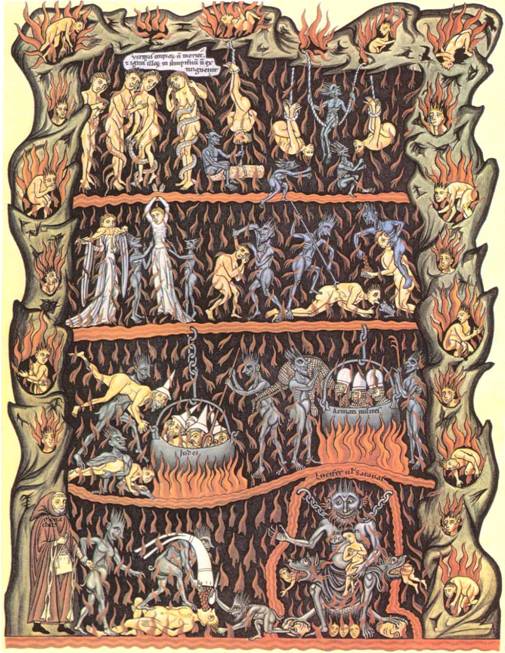
Jews were guilty—of killing Christian children, of
desecrating hosts, of murdering God, of rejecting Christ—the linkages were
made permanent in pictures, as well as explained in ephemeral sermons and
disputations. Christian representations of the Jews as the damned par
excellence appeared on church walls and windows, in Bibles
Moralisés, in Psalters, not to mention in Christians’ own martyrologies.
Although Jews created their own visual images of burning
martyrs, these were only accessible in a private context, in illuminated
manuscripts. Church frescoes, reliefs, and stained glass windows were public.
See, for example, the series depicting the Paris Host Desecration of 1290 by
Paolo Uccello, formerly adorning the altar of the church
of Urbino (now in the National Gallery of the Marches):
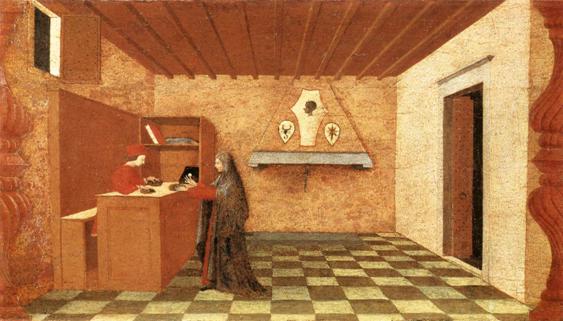
Christian
woman selling a consecrated Host to a Jewish money-lender to pay off a debt on a
dress
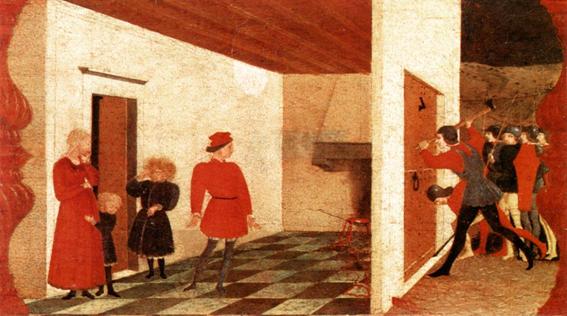
The
host “miraculously” bleeds from
the boiling pot through the door of the Jewish house to show the armed men where
to find the “guilty” host-desecrators
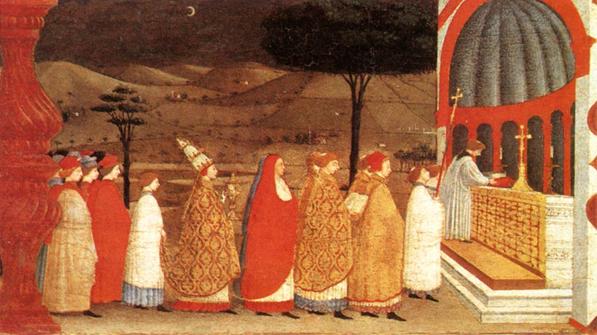
The
host is ceremoniously re-consecrated and restored to its rightful place
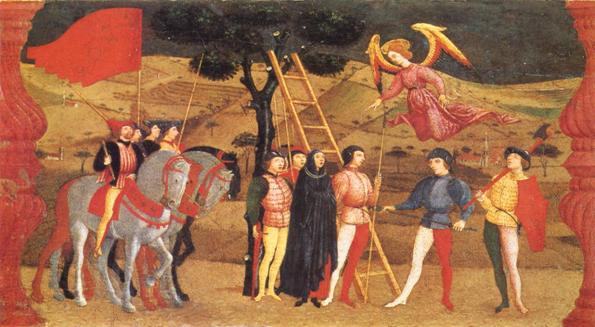
The
Christian woman is punished and an angel descends from heaven
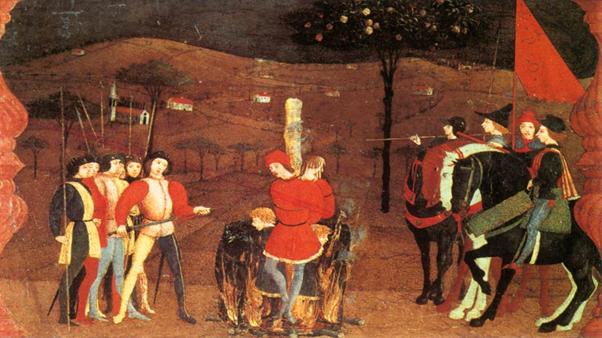
The
Jewish money-lender and his family are burnt at the stake
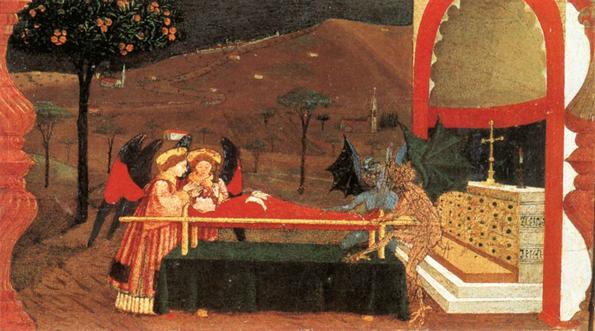
Two
angels and two devils fight over the Christian woman's body
We also need to bear in mind that the unfortunate Christian children for whose
deaths Jews were scapegoated themselves became Christian martyrs. See, for
example, Anderl of Rinn:
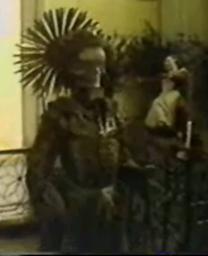
Hosts thought to have been desecrated by Jews often
attested “miracles,” and were subsequently enshrined as relics. These relics
were made into perpetual objects of veneration and reminders of the Jewish
turpitude, ceremoniously displayed during processions on the martyr’s feast
day or in permanent church installations.
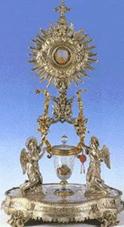
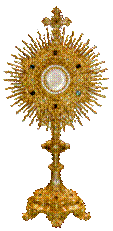
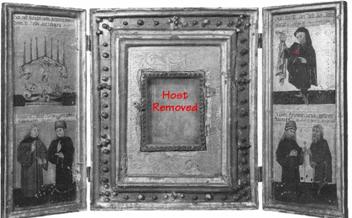
It is no coincidence that one of the Christian rituals
Ephrem of Rothenberg’s 12th century liturgical song for Passover
attacks as idolatrous is “bone-worshipping.”
A satirical poem of the 13th c. southern French Jewish troubadour,
Isaac haGorni, takes the polemic even further. He speaks in the voice of an aged
adulterer:
And from afar they will bring the dust of my tomb to be
peddled to beautiful girls as cosmetics,/And the planks of my coffin shall go to
barren women, to give birth so sons and daughters…/All my instruments shall
become sacred relics, and my robes guarded like treasure!/ Oh who shall
pulverize my bones before they make them into icons (temunot)?
Each historical verdict of ritual murder produced two
distinct, competing, sets of martyrs, one Jewish, the other Christian. Each
side’s narrative represented and perpetuated the theological truth that it
held dear. Each side had its own exclusive truth claim. Martyrdom, in both
traditions, was understood as full and instantaneous atonement for
sin—complete vindication. Thus, that each side saw its co-religionists as martyrs was per se vindication of its own religious claims.
If we move ahead to the mid 17th c. in Eastern Europe
to the Chmielnitzky massacres, we discover that Rabbi Nathan Hanover’s
chronicle, Yeven Metzulah (Abyss of
Despair) shares some of the same characteristics as its Western European
predecessors. Hanover graphically depicts the martyrs’ deaths; their deaths
are Kiddush hashem; the assault is
interpreted as retribution for Jewish sins following the tzidduk ha-din tradition;
women choose death over rape; an exclamatory prayer for divine retribution is
repeatedly invoked, as is the prayer for messianic redemption;
the only martyrs whose names are mentioned are rabbis; and religious articles
are graphically portrayed as defamed and destroyed.
Despite these familiar tropes, the account develops several
nova: First, some of the Jews choose capture and escape over death,
anticipating their redemption by the Jewish communities of Salonica and Constantinople
and their asylum in Turkey, north Africa, and Egypt. Although Hanover makes clear that the preferable course of action is to follow the rabbinic view
and to choose martyrdom, he chooses to narrate an alternative.
Second, while the fear of forced baptism is still expressed, there are no
accounts of polemical interchanges between Christians and Jews. In fact,
following his descriptions of Jewish calamities, Hanover often adds a sad reflection on the destruction of churches and murder of
Catholic priests, sometimes refracted through the citation of a Biblical verse.
The Christian nobles’s deaths are described in detail, and, in one case, that
of Duke Jeremy Wiśniowiecki of Tulczyn [then Little Russia, now Polish
Ukraine], Hanover appends the words traditionally reserved for Jews: “zichrono livracha,”
may his memory be for a blessing. Furthermore, Hanover interprets Wiśniowiecki’s initial escape from Cossack violence as an act
of God.
Similarly, when mentioning the election of Cardinal Frederick Casimir of Gniezno
as King, Hanover adds the phrase, “may his glory increase. . . May his Kingdom grow and my he
cause his enemies to fall under him. . . and be blessed with length of days. For
he is a just King, a god-fearing man, and a friend of Israel.”
Perhaps Wiśniowiecki earns the rabbi’s admiration by issuing a decree
that reversed forced baptisms.
Yeven Metzulah marks a ground-shift in the martyrological
portrait of Christians, admittedly as much a result of socio-political alliances
as any theological conviction. Yet a related theological shift may also be
detected. Hanover writes that when a group of Jews narrowly escaped massacre, they recited the
blessing, “Blessed are you, O God, who resurrects the dead.” This
reconstruction of resurrection as the triumph over death in this life, rather
than its postponement to the afterlife, reflects a new understanding of Jewish
survival as literally dependant on bodily existence. The violate dietary laws to
stay alive.
Taken together with Hanover’s reporting of pidyon
shevuyim, the ransom of captives, we begin to see a community unwilling to
hand its fate entirely over to a transcendent, omnipotent, God, as Hanover
reveals: “The Jews there placed their trust first in God, and then in them
[the Dukes], thinking that they might find refuge for themselves and their
families.”
The fact that some Jews were able to find protection with these Christian nobles
and clergy initiated the slow erosion of the polemical power of martyrology for
Jews in the modern period.
Post-Shoah Notions of Martyrdom
In the post-Shoah era, it has become customary to refer to
the six million Jews who perished in the Shoah as martyrs. Although most Jews
killed by the Nazis were given no choice other than death, the appellation has
become quite common. Yad Vashem’s English name is “The Holocaust Martyrs’
and Heroes’ Remembrance Authority.”
Already, in this title, we sense a shift in the theological understanding of the
term, “martyrs,” by its juxtaposition to the term, “heroes.” The heroes
are those who survived, while the martyrs are those who perished. This
distinction is not evident in the classical sources. In fact, the three young
men of Daniel 3 who survived the furnace ordeal were continually referred to as
martyrs in both Jewish and Christian tradition. People who demonstrated
willingness to die for their faithfulness to God and the Law through their
radical actions were considered martyrs, whether they actually died or not. By
so doing, martyrs were
heroes: they exemplified courage. They were willing to battle death, whether
they prevailed or not. I suspect that in making this distinction, the voluntary
aspect of the classical definition has also been set aside. In the
post-Enlightenment age of individualist consciousness, it is almost
inconceivable to envision choosing death as a real choice rather than one
coerced by a system of violent oppression or false consciousness. As Allen
Grossman writes, even, “The Holocaust was not a challenge to Jewish martyrdom
but an attempt to destroy martyrdom forever. . . [Hitler] decreed death for
Jews, not for doing or even believing, but rather for being. . . Thus, Jewish
martyrdom was made irrelevant. . . A martyr chooses to die. . .”
Grossman quotes the famous dictum made by R. Isaac Nissenbaum in the Warsaw
ghetto, “this was a time not for Kiddush ha-Shem, but rather for Kiddush ha-chayyim
[sanctification of life].” This post-Shoah theology has permeated Jewish
consciousness so deeply that it distorts our understanding of pre-modern notions
about martyrdom. To cite just one example, Hayyam Maccoby writes, “[T]he
concept of martyrdom carries no special mystique in Judaism; it has no
sacrificial connotation, and consequently no import of vicarious atonement….
Martyrdom is never to be sought; he who embraces it by failing to seek safety in
flight is a sinner. . . . The basic life-affirming meaning of Kiddush ha-shem,
however, was reasserted in the halakhic ruling that during the Nazi era the
truest Kiddush ha-shem was to preserve one’s life if possible, since the Nazi
aim was not only to destroy the Jewish religion but the Jews themselves.”
Another classical aspect of martyrdom, tzidduk ha-Din, is
also discarded. With the exception of some early post-Shoah orthodox rabbinic
responses to the Holocaust maintained today by ultra-orthodox groups, most Jews
find that the concept of martyrdom as divine judgment is blasphemous when
applied to the Shoah. As Norman Lamm has written, “the very idea is repugnant
to me and bespeaks an insufferable insensitivity. . . .
[I]n these special circumstances of such unprecedented butchery and
unequaled suffering and unimaginable danger to our survival, recourse to mi-penei hata’einu [we were punished for our sins] is massively
irrelevant, impudent, and insensitive.”
In fact, the preference for the term, “Shoah,” catastrophe, over
“Holocaust,” rejects attempts to find meaning in sacrificial theologies of
salvation.
Nevertheless, in the Jewish liturgy
for Yom HaShoah created by Elie Wiesel and Albert Friedlander, the opening
prayer reflects, “There are times when songs falter… when martyrdom becomes
a constellation of faith against the unrelieved black of space about us.” In
their version of the El Male Rachamim,
the Memorial prayer, recited for the six million at Yizkor services as well as
on Yom HaShoah, the six million are identified by the phrase, “shemeitu
al kiddush hashem—those who died in sanctification of the name.” The
Conservative movement prayer book, Sim
Shalom, uses a similar unique adaptation of the memorial prayer, but rejects
the theological classification of the “six million” as martyrs by eschewing
any reference to “kiddush hashem.”
No special memorial prayer appears in the Birnbaum siddur, which only provides
the traditional yizkor prayer for martyrs in general. Although the interreligious service by
Gene Fisher and Leon Klenicki also avoids any form of the word martyr, the
recitation of Psalm 22, the very psalm recited by Jesus—preserved in Hebrew or
Aramaic in the Matthean (27.46) and Markan (15.34) passion narratives—implies
a connection between what Christians regard as the paradigmatic martyrdom and
the deaths of the six million.
This remarkable link figures prominently in Marc
Chagall’s famous “White Crucifixion,” painted in 1938:
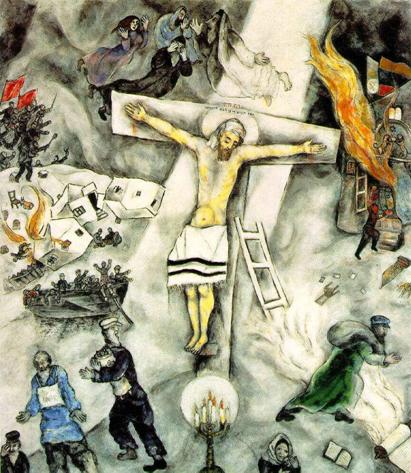
Karl Plank writes, “As the prayer shawl wraps the loins
of the crucified figure, Chagall makes clear that the Christ and the Jewish
sufferer are one,”
as in the work of Sholem Asch.
In 1977, the artist himself explained the symbolism of the crucifixion series:
“For me, Christ has always symbolized the true type of
the Jewish martyr. That is how I understood him in 1908 when I used this figure
for the first time…It was under the influence of the pogroms. Then I painted
and drew him in pictures about ghettos, surrounded by Jewish troubles, by Jewish
mothers, running terrified with little children in their arms.”
Many would find this view offensive, as typified in the Auschwitz
convent controversy. In the book, Memory
Offended, Stanislaw Krajewski wrote,
The word [martyrdom] is not neutral. In both Jewish, and
subsequently Christian traditions it means suffering for the sake of one’s
faith. . .. Auschwitz, or the Shoah in general, does not have this redemptive quality. It is an
ultimate horror: Jews were condemned independently of their willingness to
defend their faith, indeed independently of their behavior. For most believing
Jews, Auschwitz
must have meaning, but that meaning seems totally hidden. In contrast, from the
Christian point of view, the redemptive interpretation is natural. Even Pope
John Paul II, whose sensitivity to the Jewish fate is obvious, expressed remarks
to the effect that so great a suffering must bring great fruits [citing the
pope’s visit to Poland
and his meeting with Jewish representatives on
6/14/87].”
We find a different treatment of the crucifixion in a story recorded by Yaffa
Eliach from Zvi Michalowski entitled, “Jew, Go Back to the Grave!” Eliach
relates that on the eve of Rosh Hashana, over 4,000 Jews had been herded into
the main synagogue of Eisysky, Lithuania. They were led out in groups to the cemetery, and gunned down into open
ditches. Zvi Michalowski, then a young man, jumped into the grave just before
the bullets hit, and then climbed out hours later. Naked and dripping with
blood, he headed toward the Christian section of town and knocked on the first
door he came to. “Jew, go back to the grave where you belong!” came the
response, time after time. Finally,
he confronted a widow whom he knew, saying:
“I am your Lord, Jesus Christ. I came down from the
cross. Look at me—the blood, the pain, the suffering of the innocent. Let me
in.” The widow crossed herself, and fell at his blood-stained feet. . . she
kept crossing herself and praying. The door was opened. . .
Whether or not the actual interaction happened as Eliach
tells it is beside the point. What is remarkable is that the story stands as a
perpetual memory of Jewish escape from death during the Shoah. The self-portrait
of a persecuted Eastern European Jew in 1941 as Christ is both ironic and
irenic. The irony has a polemical edge to it: the widow only treats Michalowski
kindly when he poses as Christ and hides his Jewish identity. The irony, of
course, is that Jesus was himself Jewish. Yet there is a tone of reconciliation
in the identification as well: Michalowski recognizes that from a Christian
perspective, suffering is typified by the crucifixion. Thus, if he wants the
widow to empathize with his suffering, he must express it in Christian terms. In
doing so, he sees the world through the other’s eyes. The fact that he can
overcome his parochialism while the widow cannot suggests that the polemic has
the last word with an inverted sort of triumphalism: Jews, the minority, must
constantly translate their world into the terms of the majority, while the
Christian majority remains complacent in its insularity. Thus, despite this
brief moment of rapprochement, Jews can narratively avenge our trauma and
overcome our post-Holocaust terror by representing subversion and deception as
the secrets to our survival. In this theology, martyrdom only works if there is
bodily resurrection. And bodily resurrection is construed here as a new kind of
triumph over death that entails clinging to bodily life.
Conclusion
I would like to conclude with a few personal reflections.
The topic of martyrdom has captivated my attention for a long time. Yet the
distance achieved by texts that record these deaths, either by their appeal to
allegory, metaphor, symbolism, and/or Biblical motifs, has allowed me to avoid
confronting the theological challenge these traditions pose to my own religious
commitments. To be honest, I am uneasy with a tradition that valorizes death
without demanding critical scrutiny of the social structures that allowed it to
happen in the first place. I am uncomfortable with theological assertions about
death as redemptive or atoning. And here is where my intellectual study of
Christianity and my personal faith divide. The God to whom I pray does not
demand human sacrifice. I know that Jews have believed such ideas for millennia,
but I find myself rejecting this aspect of my own tradition in deference to its
ethical demands.
I once conducted an adult study session at a local
synagogue on this morning’s subject, martyrdom, and I asked the participants
how these stories and poems made people feel. Most were unsettled by the images,
and even were repulsed by the idea of martyrdom—all except the rabbi, who
declared with confidence, “I think I would have to choose martyrdom if faced with apostasy. How could I
fulfill my role as a model of faith for my community if I didn’t? That’s
part of being a rabbi.” I was deeply challenged by this assertion. And that is
a challenge with which I continue to struggle.
NOTES
Jerome, Ep 7.6; Chrysostum, Homily
on the Holy Martyrs 2, Augustine, s.
300.6. See M. Vinson, “Gregory Nazianzen’s Homily 15 and the Genesis of
the Christian Cult of the Maccabean Martyrs,” Byzantion
64 (1994): 166-92. Also ROUWHORST,
Gerard: "The Use of the Cult of the Maccabean Martyrs"
(unpublished?).
In its occurrences in the Babylonian Talmud, the phrase (kedushat
hashem) has the same meaning as in the Palestinian traditions about the
three prohibitions one must die rather than violate (cf. Sanhedrin
74b, Pesachim 53b). It adds
another layer of meaning, however, that of bringing public honor to the
Jewish God by conducting business with a gentile in the same manner as with
a Jew (Babba Kamma 113a, Gittin 46a—keeping an oath to non-Jews). This is a far cry from
martyrdom.
 Roughly
contemporary with this shrine is the only piece of epigraphic evidence I could
find for Jewish martyrdom during this period. A Hebrew inscription (#239) from
the Beit She’arim catacombs in the Galilee
identifies a sarcophagus as containing the remains of Rabi Aniana and his
brother, whose name is unreadable:[12]
Roughly
contemporary with this shrine is the only piece of epigraphic evidence I could
find for Jewish martyrdom during this period. A Hebrew inscription (#239) from
the Beit She’arim catacombs in the Galilee
identifies a sarcophagus as containing the remains of Rabi Aniana and his
brother, whose name is unreadable:[12]
